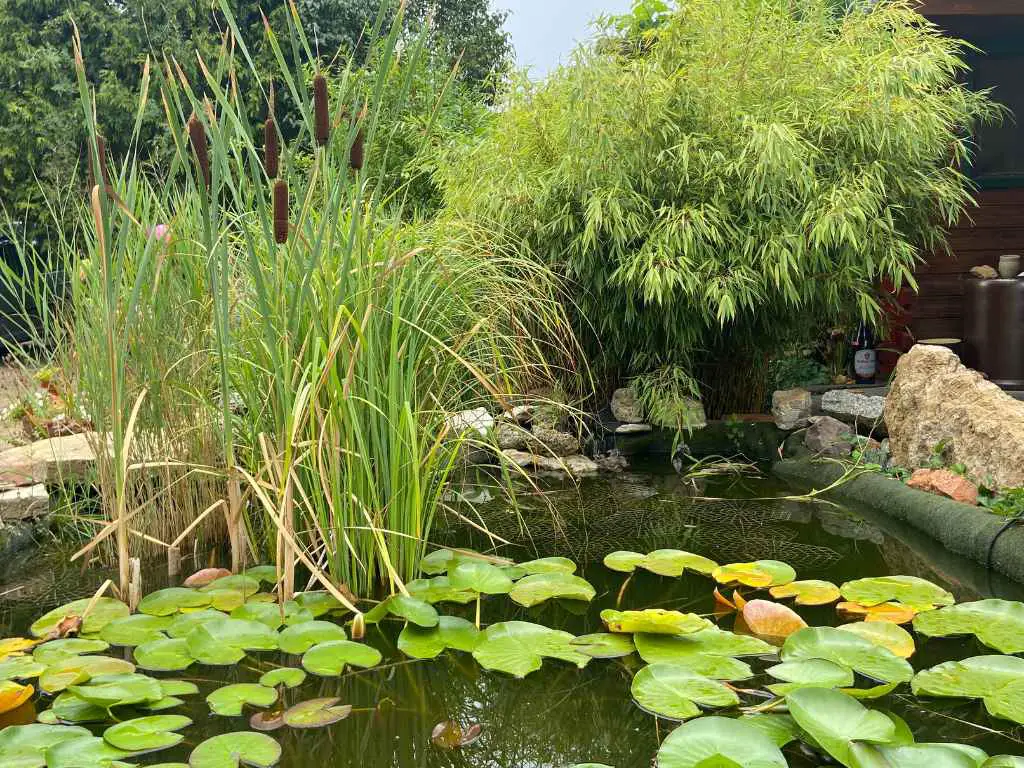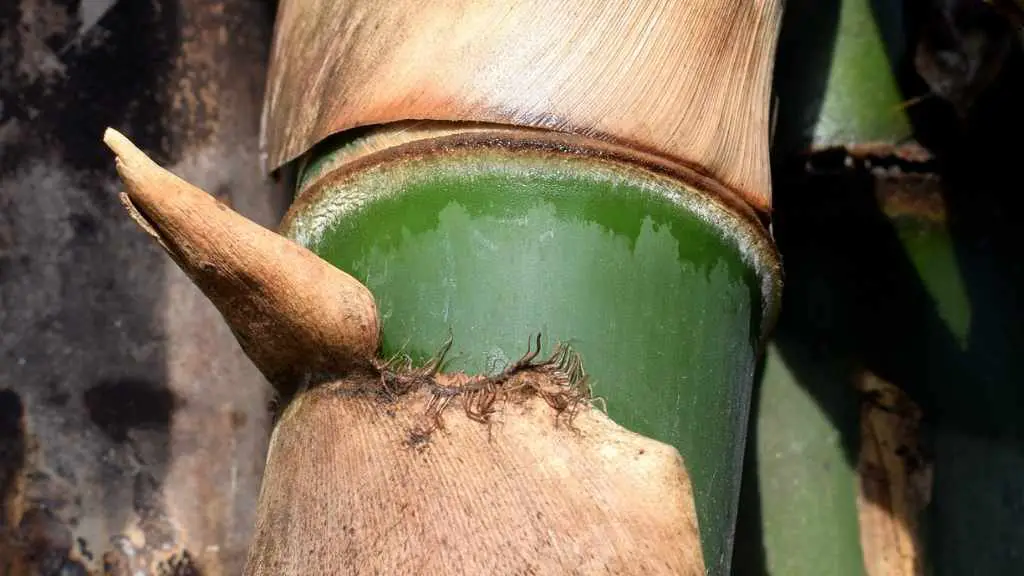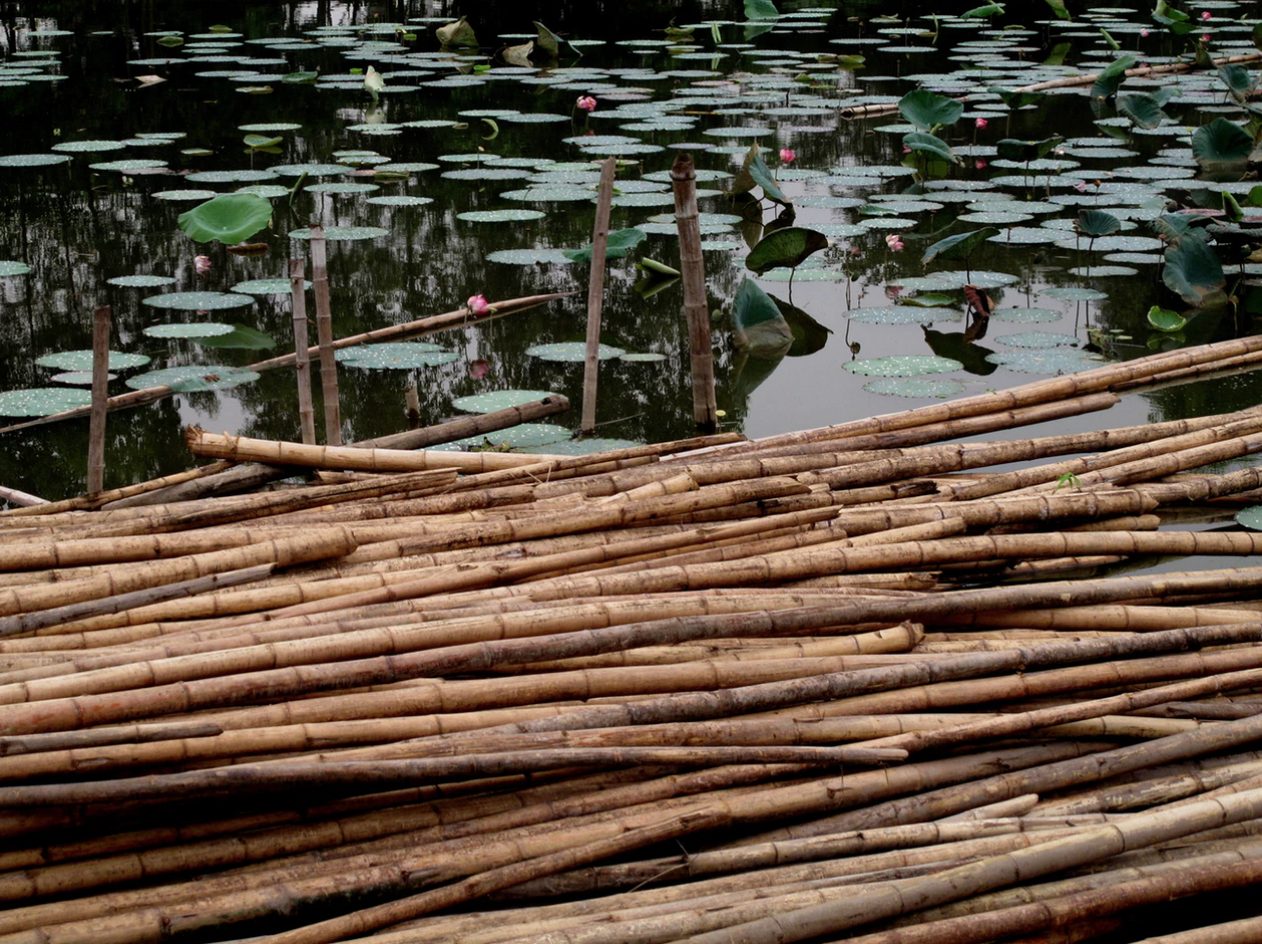Sitting quietly by the koi pond, listening to the trickling of the fountain, and breathing deeply from the abundance of zen, I wonder if I can plant some beautiful bamboo in my water feature. With all those tropical varieties of bamboo, and all those ponds and marshlands in the tropics, will bamboo actually grow in the water?
Contrary to what you might think, bamboo does not grow in swamps or wet, saturated soil. Bamboo needs soil with good drainage. So it will not grow in ponds, and you can’t grow it too close to the lake shore or the riverside. But there are a handful of bamboo species that can tolerate more water than others, including Phyllostachys heteroclada, also called “Water Bamboo”.
NOTE: This article first appeared in August 2019, last updated in November 2022.
Bamboo is an amazingly versatile plant, and with thousands of species and cultivars to choose from, you can find a variety for virtually any situation. From the oppressive heat to the extreme cold, from towering giants to dwarf ground covers, there’s a bamboo to meet your needs. Here’s a short list of bamboo species that are more water-friendly than most.
| Botanical name | Common name | Description |
| Arundinaria gigantea ‘Macon’ | Macon River Cane | Native to the southeastern US and super cold-hardy |
| Phyllostachys heteroclada | Solid Stem Bamboo, or Water Bamboo | Running bamboo that gets about 20′ tall |
| Phyllostachys atrovaginata | Incense Bamboo | Fragrant running bamboo with tasty shoots |
| Phyllostachys parvifolia | Running timber bamboo, native to China | |
| Bambusa blumeana | Thorny Bamboo, or Spiny Bamboo | Southeast Asia variety with thorny branches |
Can bamboo grow in water?
Watching old episodes of Gilligan’s Island or movies about Vietnam, it seems like they always had bamboo growing in the lagoon and around the rice patties. So what about growing bamboo in ponds, swamps and wetlands? Can I grow bamboo in the water?
It turns out those were just special effects or overly imaginative set designers, because bamboo doesn’t grow in lagoons or rice patties. Perhaps you’re like me, and you imagine a Japanese garden with fountains and goldfish, and bamboo growing out of the water alongside lotus flowers and papyrus. But unfortunately, bamboo does NOT like to grow this way.
Bamboo does NOT grow well in water or saturated soil.
Or maybe you’re thinking of “lucky bamboo“, those short, segmented cuttings you see growing in a vase of water. Well, don’t be misled. Lucky bamboo grows fine in the water, but is not a true bamboo. It is actually a type of Dracaena, an indoor decorative, sometimes referred to as “corn plant.”

Most of the time, when amateur gardeners talk about “water bamboo”, it’s this indoor ornamental they are referring to. It definitely enhances the Feng Shui, and it could very well be lucky. But botanically speaking, this is not bamboo.
Bamboo will NOT survive in a pond setting or in standing water.
Keep in mind, even if you’re growing what’s called “water bamboo”, it cannot grow in standing water without drainage. If it doesn’t drain within about five days, the bamboo will probably not survive.
But if you’re looking for bamboo that can grow in very wet soil, near the edge of a river where the water levels can rise and fall, there may a few options.
The best strategy is to plant the bamboo somewhere near the wet area and let it spread naturally. If the main root ball is on higher ground, in a well-drained area, the bamboo will survive, even if some culms and rhizomes wander too far afield and drown.
Best bamboo species for wet soils
The following varieties of bamboo have rhizomes with air canals that make them more adaptable to wet soil. Just remember, if the ground is completely waterlogged, the bamboo probably won’t make it.
Arundinaria gigantea ‘Macon’
Native to North America, this is considered to be the most cold-tolerant of all bamboos, hardy down to about -25º F. It’s also one of the most tolerant to wet soil. If you’re planting near waterways or in soil with poor drainage, this is probably your best choice. Slender, upright canes make it ideal for privacy screens, up to 20 feet tall and about 1 inch thick.

Phyllostachys heteroclada
Phyllostachys are generally native to China and thrive in temperate climates. Unlike some of the tropical and subtropical bamboos, many members of this genus can survive in very cold and sub-freezing conditions. Take a look at our article on Cold-Hardy Bamboo. Also, they are all running types of bamboo with fast-spreading rhizome root systems. Check out our article on Running Bamboo.
This species is popularly referred to as solid stem bamboo and sometimes as water bamboo. As the name suggests, the culms grow solid or nearly solid, unlike most varieties of bamboo which are characteristically hollow. (See our more detailed articles on solid bamboo and hollow bamboo.)
Although the stems are almost solid, the roots and culms do have small air canals which help them survive in very wet soil. It is also a very cold-tolerant species, hardy down to -5 or 10º F.
Its vigorous growth habit makes P. heteroclada an ideal candidate for privacy screens, especially in very cold or wet areas. The canes grow up to 15 or 20 feet tall, normally not more than 1 inch in diameter. Some nurseries list it as Phyllostachys purpurata.
Phyllostachys parvifolia
Like water bamboo, the rhizomes of this species are well adapted for wet and saturated soil. Small leaves make the thick, dark green culms stand out, and the white rings around the nodes give them even more character. Fresh shoots of this variety are reputed to be delicious in flavor.
If you’re looking for a giant bamboo in a cold or wet region, this may be your best choice. Mature shoots can get up to 40 feet tall, and nearly 4 inches in diameter. It is cold hardy down to -15º F.
P. parvifolia is difficult to propagate, however, and not widely available in nurseries or outside of China.
Phyllostachys atrovaginata
A popular species for a wide range of growing conditions, P. atrovaginata is commonly known as incense bamboo for its pleasant aroma. The culms have a waxy coating that smells something like sandalwood.
This variety spreads quickly and works great for all sorts of landscaping purposes. Mature canes normally reach up to 30 or 40 feet in height and 2 or 3 inches in diameter. It’s cold hardy down to about -10º F and does relatively well in poorly drained soil and wet regions like the Pacific Northwest.
Incense bamboo also has some of the best-tasting shoots of any species, according to the connoisseurs.
Bambusa blumeana
Commonly known as spiny bamboo or thorny bamboo, this Indonesian species has sharp spikes coming out at the nodes of the spindly lower branches. Formidable canes get 50 to 80 feet tall and 4 to 6 inches in diameter. This variety is unusual in that it can tolerate flooding and will survive in marginal areas along waterways. They also tend to grow nearly solid culms, especially near the base of the plant. At the same time, it is also very drought-tolerant.

You can sometimes find B. blumeana in Florida nurseries, but it’s generally bushier and doesn’t grow nearly as tall or thick as it does in its native Southeast Asia. The thorny culms also make it very unappealing to most gardeners. In tropical climates, including India and other equatorial regions, this species is highly valued for its strong and sturdy culms, useful for building, biomass and pulping for paper.
Conclusions
If you’re trying to landscape around a swamp or a river bank, or looking for something to grow in your pond, bamboo is probably not the best choice. There are just a handful of bamboo species that are adapted for very wet soil. But even these varieties will not survive prolonged periods (more than about five days) underwater.
Better choices in a pond are water plants like lilies, hyacinths, and duck moss. Horsetail and papyrus somewhat resemble bamboo in appearance and might help produce the desired effect. Mermaid plants and creeping Jenny are also great options that have the added benefit of oxygenating the pond water.
If you’re determined to grow bamboo around a body of water, it’s better to plant the bamboo on higher ground near the water. These varieties all spread quickly, and you can let them spread naturally within their comfort zone. If the soil is too waterlogged, it will create a natural barrier, and the roots simply won’t go there.
Further reading
If you enjoyed reading about water bamboo and the dos and don’ts of planting bamboo around ponds and bodies of water, please consider sharing the link and subscribing to our mailing list. You might also want to check out some of these popular articles:
- Watering your bamboo: How much and when
- Introducing bamboo: Genus by genus
- Water Bamboo vs Bamboo Water
- The best clumping bamboo: Never run again
- The best bamboo for hedges and privacy screens
- Growing bamboo indoors
- Bamboo bonsai: For Japanese gardens
PHOTO CREDIT: Bamboo with lotus (Unsplash)





















The eastern United States native Arundinaria bamboo grows in wetter soils as well as a tad shadier soil. Took forever to find it but I managed.
Thanks for the tip! The native Arundinarias are a fascinating breed!
Interested in bamboo around pond and water plants for oxygen
Graceful, cascading bamboo varieties like Fargesia (in cool climates) or Mexican weeping bamboo (in warmer climates) look great around ponds. Just don’t plant them directly in the water!